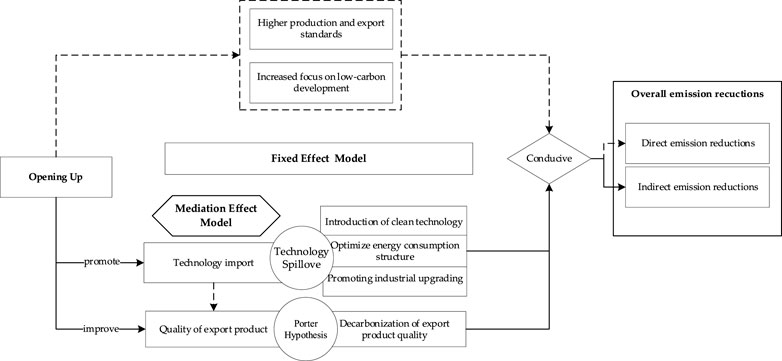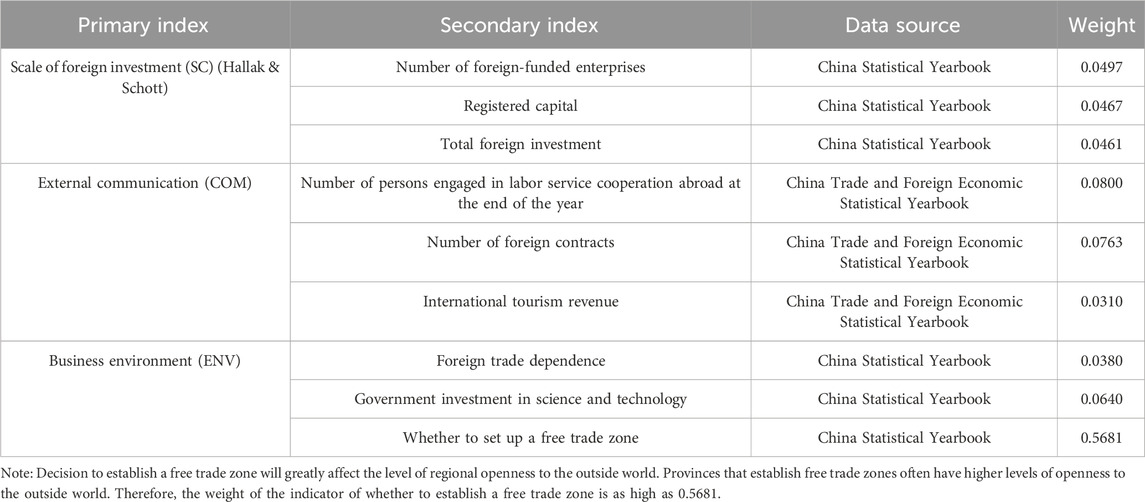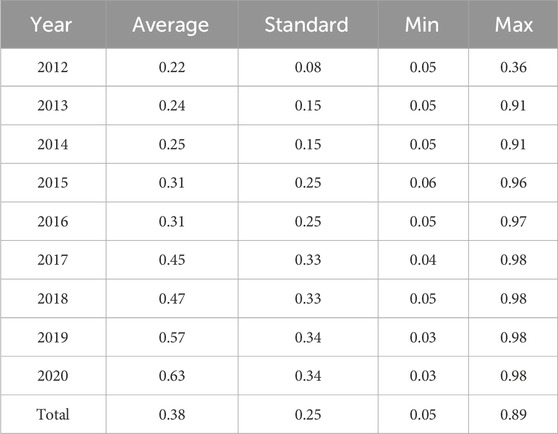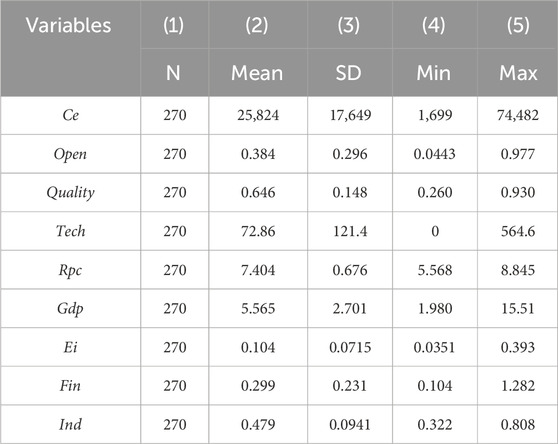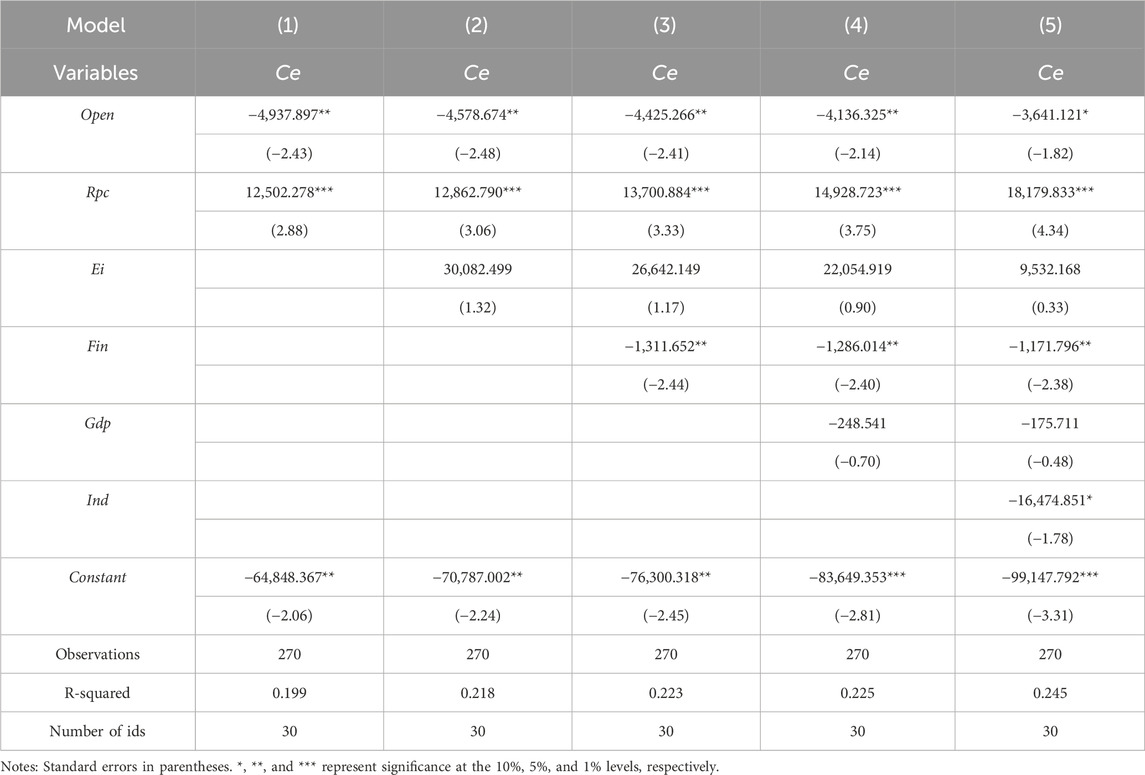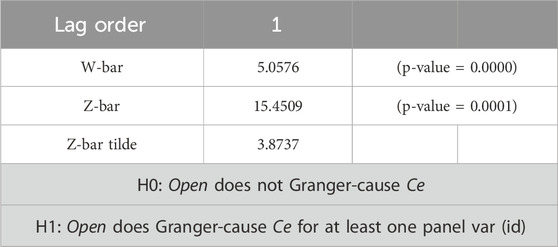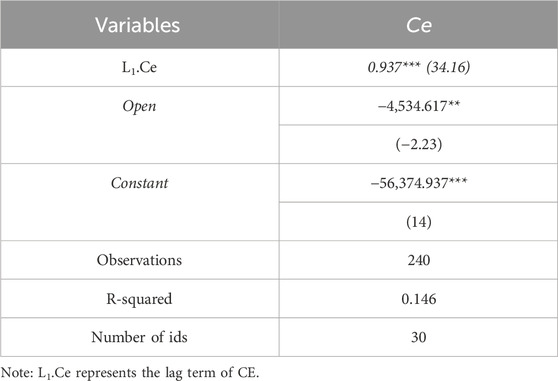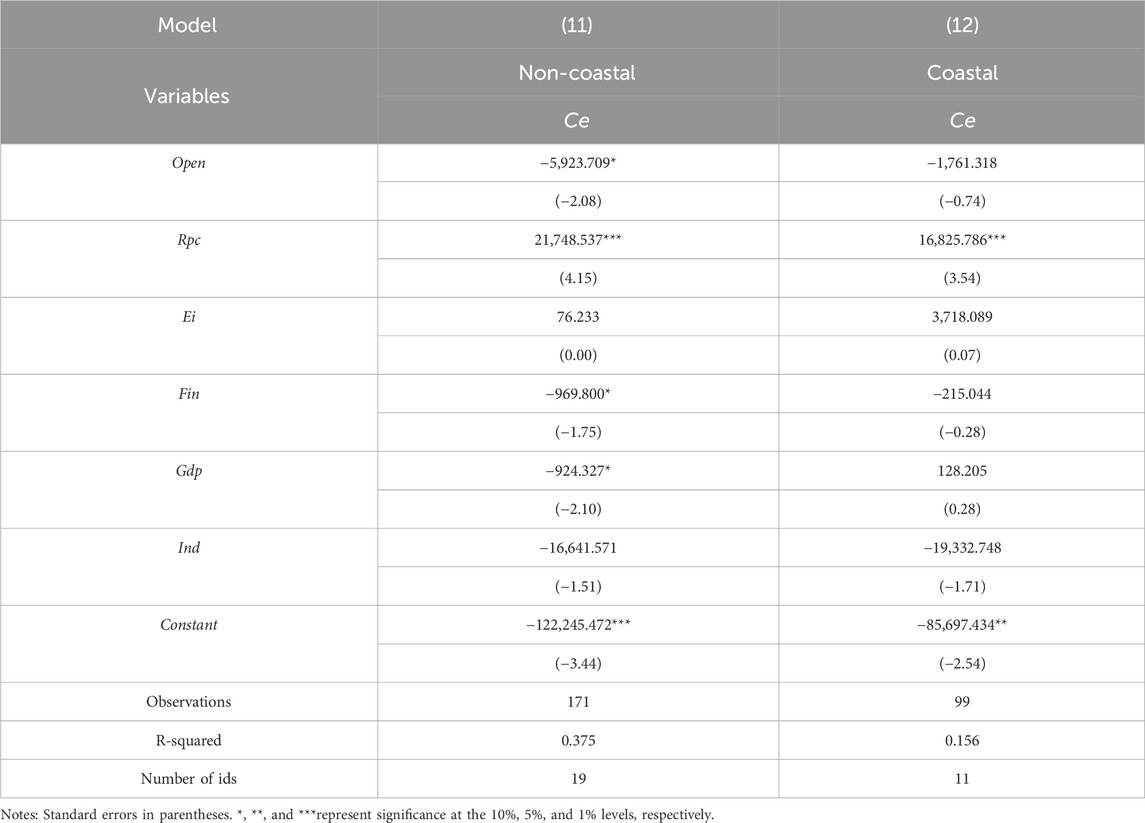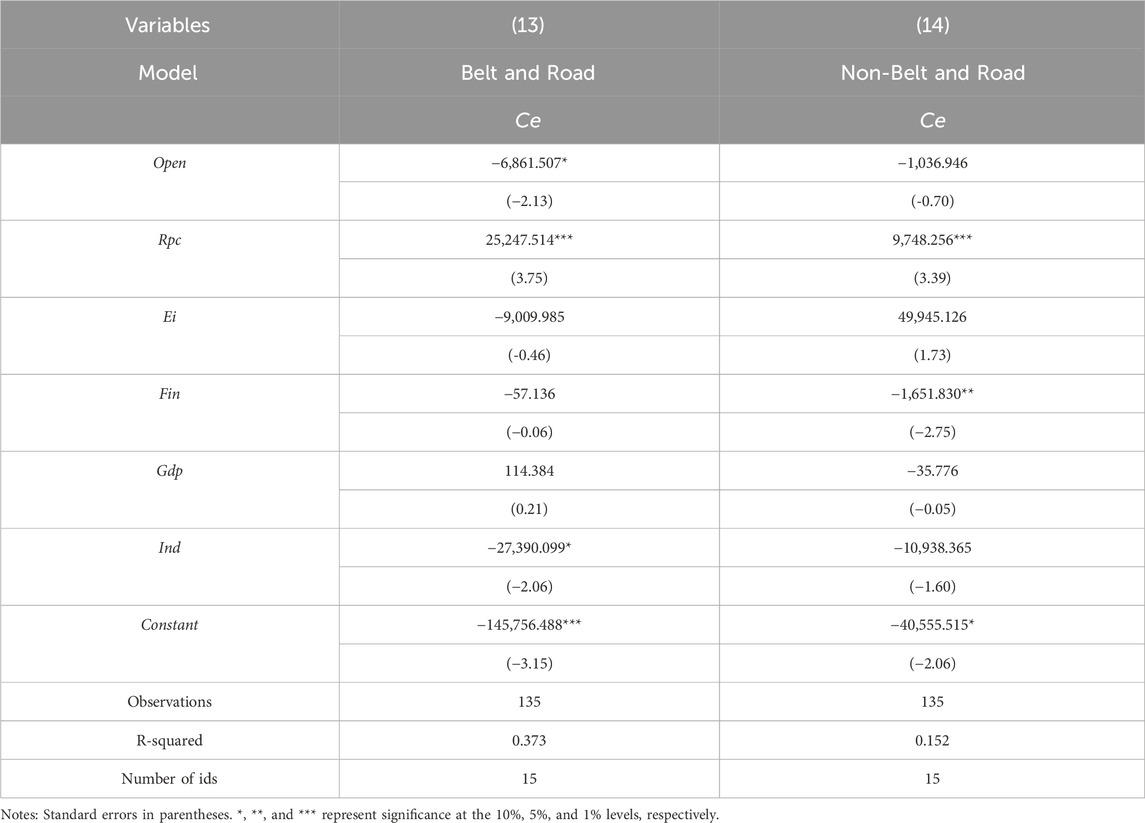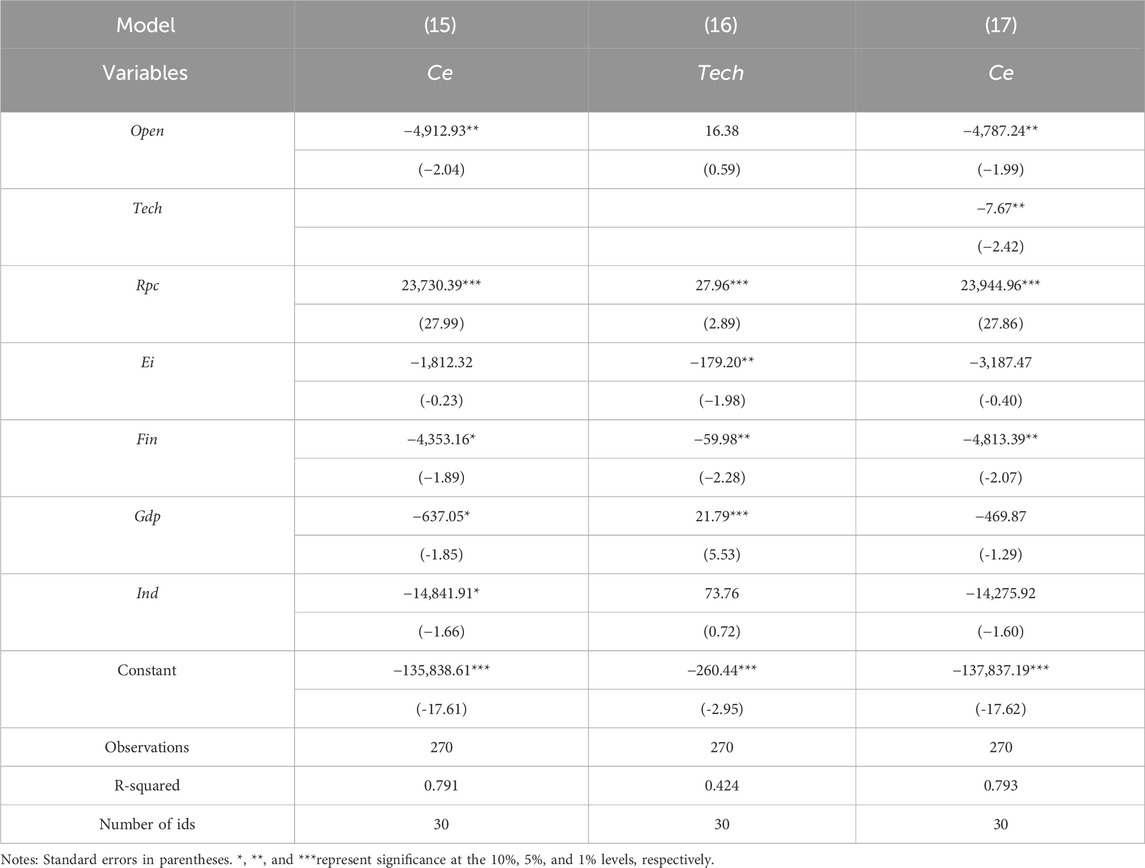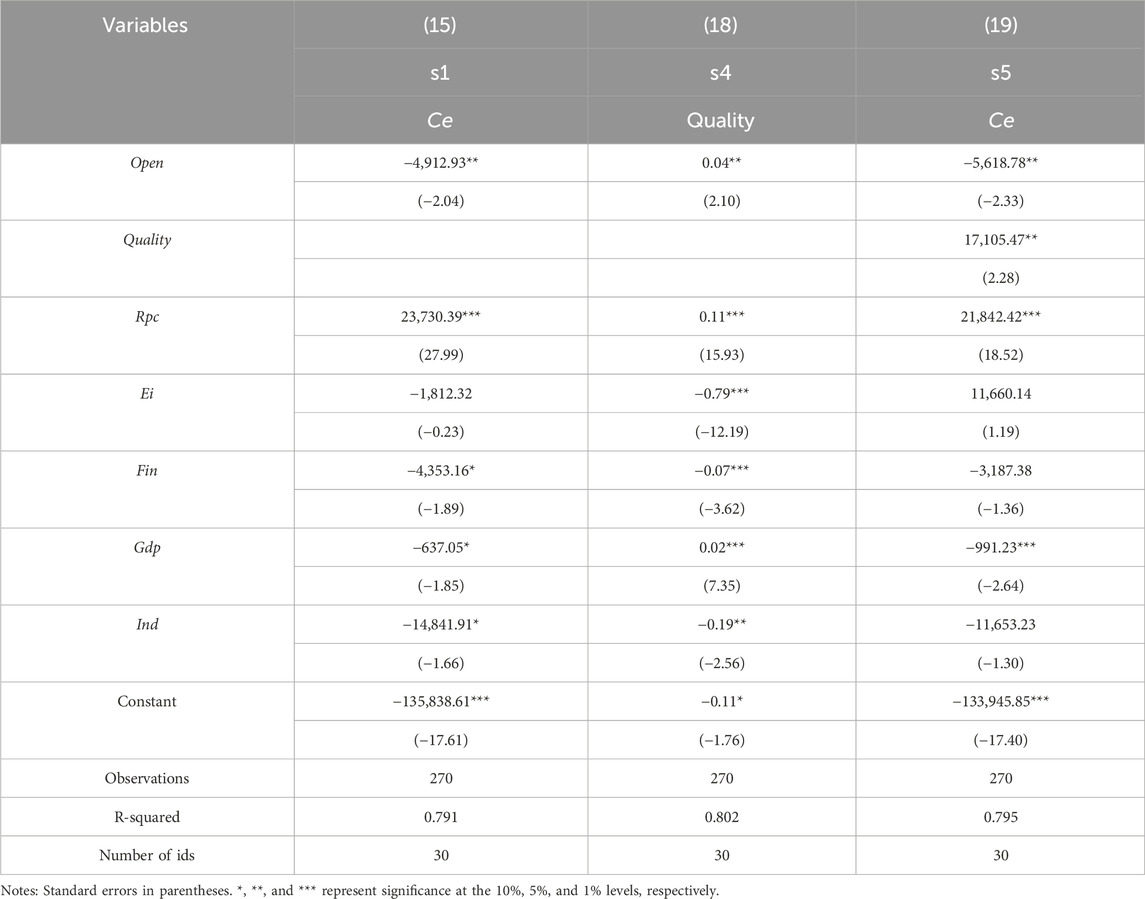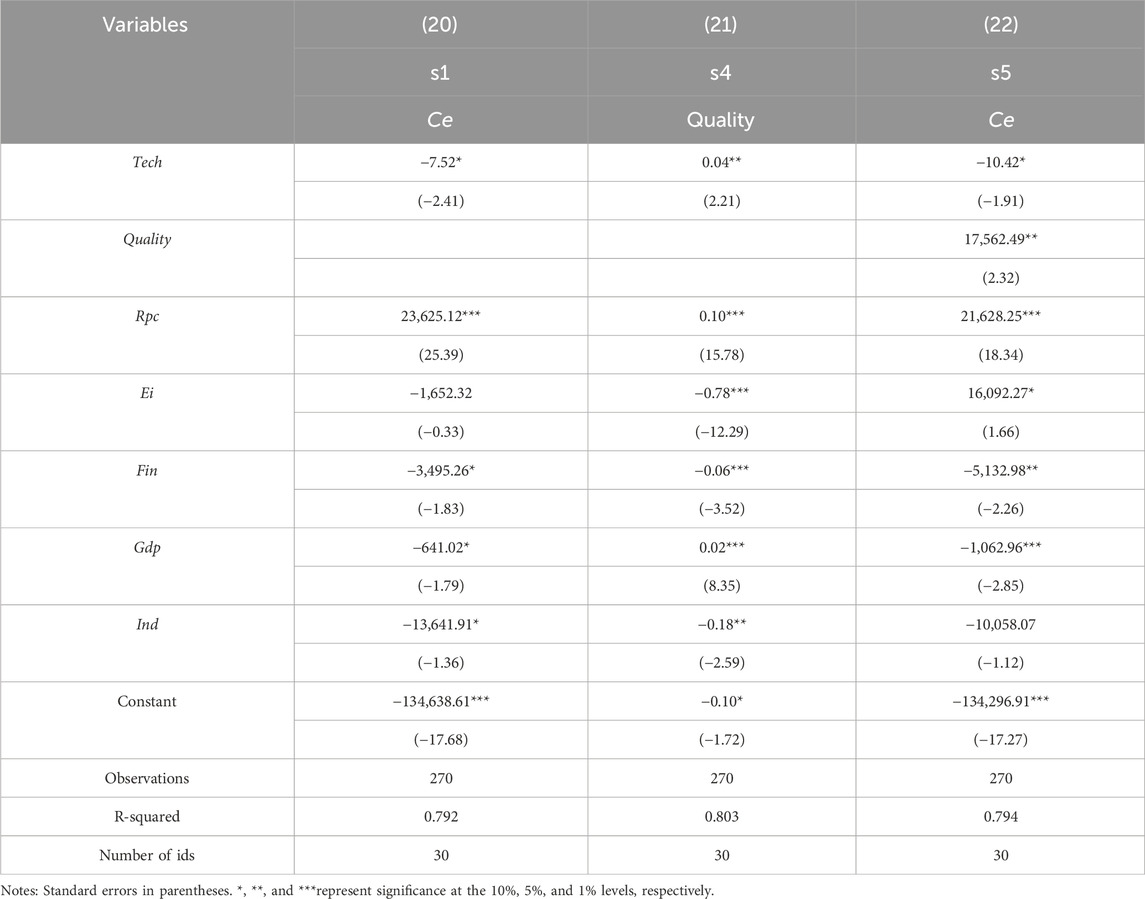- 1School of Management, Jiangsu University, Zhenjiang, China
- 2School of Finance & Economics, Jiangsu University, Zhenjiang, China
Institutional opening, which signifies a higher level of opening up to the world, enhances the linkage effect of domestic and international resources, breaks down institutional barriers, and achieves optimized allocation of factors. Energy consumption and carbon emission standards of Chinese products will be more integrated with international standards. Thus, reducing the carbon content of export products has emerged as a critical concern. In this context, this paper has used a fixed-effect model to analyze the impact of opening up on China’s overall carbon emission reduction and has explored the transmission path from the opposite direction of export product and technology import. The results are as follows: 1) The level of opening up can effectively reduce China’s total carbon emissions; 2) The quality of export products plays a positive intermediary role in this impact; 3) Technology import reduces overall carbon emissions by improving the quality of exported products. 4) The carbon emission reduction effect of opening up is more obvious in non-coastal areas and the Belt and Road provinces. Based on the empirical results, this paper has put forward several policy suggestions for the government and enterprises.
1 Introduction
In December 2022, General Secretary Xi Jinping pointed out in the report of the 20th Party Congress that China adheres to the fundamental national policy of opening up to the outside world. China will continuously provide new opportunities to the world, promote the construction of an open global economy, and strive to benefit the people of all countries.
From a domestic perspective, there has been a concerted effort to attract multinational corporations and foreign capital into the Chinese market in the period following China’s reform and opening up. The goal was to absorb advanced technologies and exceptional management practices. Leveraging the advantage of abundant labor resources, China made rapid strides within a short span of time, particularly in the manufacturing industry. For a long time, China’s extensive development model has brought significant opportunities to its economy, but it has also concealed many risks, including resource wastage, environmental pollution, and rising labor costs. Low-priced but high-pollution products have led to a rapid increase in carbon emissions, leading to high carbon content in Chinese products. Institutional opening requires that the carbon content of products be consistent with international standards, and China needs to reduce the carbon content of products. This signifies that the dividends brought by the extensive economic model are diminishing, and reducing carbon emissions has become a top priority for export enterprises.
With the gradual disappearance of China’s demographic dividend, products with low-carbon content are more welcomed globally. Thus, China’s previous high-pollution and high-energy consumption production methods are no longer sustainable. It has become more challenging to enhance profit margins through large-scale production at the lower end of the “smile curve” using labor as a production factor. To break free from this predicament, it is imperative to steer production toward a green and sustainable direction, add higher value to products, eliminate outdated production capacity, and achieve a low-carbon transformation.
From an international perspective, the prevailing trend of “de-globalization” is expected to continue, leading to a decrease in the willingness of various countries’ governments and businesses to engage in open cooperation with China. Furthermore, as traditional industries reach a bottleneck in their development, there is an urgent need for technological innovation to provide fresh impetus to regional development and stimulate the local economies. Historically, China’s trade structure primarily focused on exports. Currently, in the face of trade restrictions from developed countries, such as the carbon border adjustment mechanism (CBAM), the export situation of Chinese products is not optimistic. Therefore, it is urgent to align with international standards to improve the quality of China’s exported products.
In order to change our previous reliance on low-priced export goods, we must improve the competitiveness of our products by enhancing their quality and forming a sustainable competitive advantage. Thus, in the report of the 20th National Congress of the CPC, it was clearly proposed that the opening up of rules, regulations, management, and standards should be steadily expanded. Institutional opening refers to the integration of rules, regulations, management, and standards from international organizations and regional economic and trade agreements through specific means in specific fields, including the introduction of internationally recognized systems that are suitable for China’s national conditions and needs.
Institutional opening up means a higher level of openness to the outside world. On the one hand, it constructs a rule system that is in line with international standards, an optimal the environment for factor allocation, and is more conducive to technology import. On the other hand, a higher level of opening up has put forward higher requirements for the quality of Chinese export products. Can the improvement of technology import levels drive Chinese enterprises to use cleaner technologies and reduce carbon emissions, with the leading development of clean technology abroad? Can higher export product standards improve the quality of Chinese export products, reduce the carbon content of Chinese products, and thus reduce carbon emissions?
In order to answer the above questions, this article intends to explore the impact of China’s level of opening up on carbon emissions from the perspectives of technology introduction and export product quality. The marginal contribution of this article lies in 1) Constructing an evaluation index system to comprehensively measure China’s level of opening up to the outside world; 2) current academic research focuses more on the impact of technology introduction on carbon emissions but neglects the impact of technology introduction on the quality of Chinese export products in the current environment that advocates clean technology. This article innovatively explores the impact of export product quality on China’s carbon emissions.
2 Literature review
2.1 Research on the impact of opening up on carbon emissions
For China, opening up to the outside world is a necessary path to development, and it is crucial to explore the impact of opening up on carbon emissions. Investigations by scholars over the years have explored various aspects regarding the impact of openness on carbon emissions. Balaguer and Cantavella-Jordá (2004) compared the level of opening up in Europe, the United States (Dogan et al., 2020a), and Southeast Asia (Salman et al., 2019) and found that China’s opening up shows three characteristics: active participation in the construction of a multilateral trade system, timely adjustment of a foreign trade system according to changes in the situation, and continuous improvement of foreign exchange ability.
The opening-up level was a positive driving factor of carbon emissions (Zhao et al., 2024). Overall, the effects of opening up in the environmental domain can be broadly categorized into two theories. The first theory assumes that the impact of trade openness on pollution is indistinct and can be further broken down into scale effects, technological effects, and component effects (Farhani et al., 2014). The Green Finance Reform and Innovation Pilot Zone (GFRIP) markedly enhances carbon emission efficiency, exhibiting a sustained dynamic effect (Du et al., 2025). The foreign trade zone (FTZ) has reduced urban environmental pollution, but this effect is mainly reflected in non-resource-based cities and regional central cities (Xu, 2025). The second theory is the pollution haven hypothesis (Lee and Lim, 1983), which suggests that trade openness brings in foreign direct investment. As different countries maintain varying environmental standards, polluting industries might opt to operate in nations with lower standards, thereby creating “pollution havens.”
In validating the first theory, foreign direct investment (FDI) is seen as a significant measure of openness. The FDI has a negative impact on carbon emissions and a positive impact on carbon emission efficiency, which reduces carbon emissions in host countries (Wang and Zhang, 2022). Higher levels of trade openness correspond to reduced CO2 emission intensity and total emissions (Fan et al., 2019). The emission reduction effect brought by trade openness in producer services is more significant (Shu et al., 2025). Some scholars have also found that FDI does not directly influence carbon emissions, but the accompanying technological advancements from foreign direct investment could rapidly enhance energy efficiency, leading to a decrease in carbon dioxide emissions (Lee, 2013). Some scholars focused on the decoupling of foreign trade and carbon emissions. It was found that there were two breakpoints in the impact of trade openness on carbon emissions through the Tapio decoupling model and the structural threshold model. Once the structural breakpoint is exceeded, trade openness will restrain carbon emissions and help achieve global carbon neutrality (Wang et al., 2023). Research on the decoupling relationship between trade and carbon emissions among multiple economies shows that China has undergone rapid and continuous increases in both intermediate and final indirect CO2 emissions compared to the United States and the European Union from 1995 to 2015 (He and Hertwich, 2019). The relationship between the export of the United States to China and the change of carbon emissions embodied in the trade was positive through the study of the decoupling of carbon emissions in Sino-US trade. US exports to China and their implied carbon emissions are rising (Wang and Han, 2021).
Regarding the validation of the pollution haven hypothesis, research has indicated that a higher political level of policy openness is negatively associated with carbon reduction efforts. In other words, higher policy openness levels tend to hinder carbon reduction (Zhang and Zhuang, 2023). Taking the example of the Belt and Road Initiative countries, it has significantly increased the carbon emission intensity of cities along the route in China (Chen et al., 2024a), while it has led to the transference of pollution across nations (Cai et al., 2018). Additionally, scholars have employed panel regression and a generalized method of moments to validate the pollution haven hypothesis between globalization, foreign direct investment, and carbon emissions (Ke et al., 2022).
In addition, domestic and foreign scholars have focused on the impact of other policies, such as carbon reduction policies, on carbon emissions. High-quality carbon reduction policies are crucial in addressing global climate change and reducing carbon dioxide emissions (Meng and Xu, 2023). Carbon emission policies reduce carbon emissions by incentivizing energy-intensive enterprises to engage in green innovation (Liu et al., 2023a). A carbon surtax can effectively reduce carbon emissions from building construction (Stefan et al., 2019). Flash policies in China, Japan, South Korea, and Mongolia in the 2010s were generally beneficial in terms of slowing down FFCO2 growth rates (Lev et al., 2019).
2.2 Research on export product quality
The definition of product quality is multi-standard and multi-dimensional. It is often understood as the product characteristics that enhance the utility level of consumers under the same amount of consumption. These characteristics include physical characteristics such as product ingredients, functions, and methods of use, along with customer perceptions of product quality brought about by the enterprise’s brand and specific marketing activities. Therefore, enterprise product quality is not only affected by research and development innovation but also depends on quality perception, such as advertising and brand investment, and effectiveness in image and other aspects (Kugler and Verhoogen, 2012). Hallak and Schott (2011) used this feature to define product quality as an intangible attribute that can change consumers’ subjective evaluation of products. In terms of the study on the relationship between the quality of exported products and carbon emissions, scholars have identified a negative correlation between the quality of exported products and carbon emissions through autoregressive distributed lag (ARDL) estimation (Gozgor and Can, 2017).
Some scholars have found that trade policy openness is positively correlated with carbon emissions, which is mainly reflected in the quality of exported products (Fang et al., 2019). A 1% increase in PM2.5 was found to be associated with a 0.25% decrease in export product quality (Chen et al., 2024a). A 1% increase in export quality increases carbon emissions by 0.139% in non-OECD countries and reduces carbon emissions by 1.327% in OECD countries (Malik, 2024). In the manufacturing industry, digital transformation enhances export carbon emission efficiency through the improvement in export product quality (Zhao and Zhang, 2025).
Scholars have also reached an opposite conclusion. Dogan and others examined the impact of export product quality on carbon dioxide emissions from 1971 to 2020. Their empirical results indicate that urbanization and export quality exacerbate environmental degradation (Dogan et al., 2020b). In terms of firm heterogeneity, the quality of exported products of high-energy-consuming firms is more sensitive to changes in trade development policies (Ma, 2022).
2.3 Research on technology import
Technology import is an important part of technological progress (Fisher-Vanden et al., 2006). Technological progress refers to the process of continuous development and improvement of old technologies and continuous iteration and updating of new technologies. Some scholars have found that technology import mainly relies on direct technology purchase or indirect foreign direct investment to achieve technological progress (Sagar and van der Zwaan, 2006). For developing countries, technology import are one of the more effective ways to achieve technological progress.
Meanwhile, the impact of technology import on carbon emissions is also worth considering. Some scholars believe that technology import can reduce the low level of domestic industrial technology innovation (Li et al., 2023), optimize the industrial structure (Wen and Li, 2014), improve the efficiency of energy utilization (Neelis et al., 2007), and reduce the unit pollution treatment cost (Zhang et al., 2014) and other aspects to reduce the overall carbon emission level. Low-carbon technologies (LCT) import boosts domestic green innovation (Cobbold et al., 2024), and LCT product trade significantly stimulates green entrepreneurship (Susantiningrum and Rapih, 2025). The low-carbon pilot city policy does help to improve ecological efficiency, which results from the mechanism of green technology innovation (Du et al., 2021).
In contrast, some scholars have found that technology transfer is not conducive to carbon reduction. Danish et al., using the ARDL model, discovered that technology transfer is the primary cause of domestic carbon emission growth (Danish et al., 2018). Teng compared the impact of domestic and foreign technology transfer on energy consumption intensity and found that foreign technology transfer has a significant negative impact on the energy consumption intensity of the industrial sector in our country, while the impact of domestic technology transfer is minimal (Teng, 2012). Song et al. pointed out that the spillover effect of foreign technology import could affect environmental quality (Song et al., 2015).
2.4 Literature summary
As shown above, research on the impact of the level of opening up on carbon emissions has mostly focused on improving technological efficiency and reducing carbon emissions through technology introduction, and has achieved rich results. However, among the existing literature, there are few studies that consider the impact of export product quality on carbon emissions. After the implementation of export restriction policies for products such as CBAM, improving the level of opening up to the outside world and actively aligning with international standards and rules are important means to enhance export products and strengthen international competitiveness. Therefore, this article has explored the impact of increasing the level of openness to the outside world on product quality and further explores its impact on carbon emissions, which is cutting-edge and forward-looking.
In addition, current studies are more focused on exploring the impact of foreign trade on export product quality. Compared to foreign trade, the level of opening up to the outside world has more policy attributes and will affect export product quality from more perspectives. Therefore, in order to more scientifically characterize the level of openness to the outside world, this article has constructed an evaluation index system to reflect the level of openness to the outside world, which can better highlight its impact on various aspects.
3 Mechanism analysis
3.1 Benchmark impact
Opening up to the outside world has broken down trade barriers of various countries and formed a global trade network. The reduction or elimination of tariffs has eliminated trade barriers caused by geographical transportation distances, making trade more convenient (Feng et al., 2022). Enterprises in network member countries can break through the limitations of geographic distances and form closer trade exchanges, promoting the extension of global value chains and industrial division of labor (Bloom et al., 2016). Simpler, more efficient, and cost-effective trade policies, and simpler access to negative list policies, have led to a significant increase in the scale of foreign trade and investment, thereby affecting the quality of the regional environment (Guo and Wang, 2023).
With the deepening of industrial structure upgrades, enterprises with high energy consumption, high pollution, and low value-added are gradually eliminated, and factors of production gradually flow to low-carbon emission industries (Su et al., 2020). In addition, with the concept of sustainable development taking root in people’s minds, cities are also paying more attention to the use of green and clean energy, improving the efficiency of energy utilization, accelerating the transformation of the energy structure, and realizing the goal of carbon emission reduction (Chen et al., 2019). Regionally, with the signing of the Regional Comprehensive Economic Partnership, the increase in openness to the outside world has forced Chinese enterprises to integrate into international production standards and requirements. Scholars have found that the impact of openness on environmental quality depends on a country’s level of development, with high-income countries practicing openness to the outside world contributing to carbon emission reductions, while the opposite is true for low-income countries (Le et al., 2016). For example, the implementation of CBAM policies will force Chinese enterprises to use cleaner energy and reduce carbon emissions throughout the entire lifecycle of product production. Regions with high levels of openness to the outside world will invest more fiscal expenditure to create a favorable investment and ecological environment to attract foreign investment (Zhuo et al., 2021).
Hypothesis 1. Improving the level of opening up can reduce overall carbon emissions.
3.2 Impact path
The impact of opening up to the outside world on China’s carbon emissions in terms of technology import and export product quality.
3.2.1 Technology import
From the import side, with the implementation of the level of opening up, the efficiency of international technology import is also improving. Although there are still trade barriers among countries to a certain extent, the technology integration brought by the open economic environment cannot be avoided. This paper argues that technology import can achieve carbon emission reduction through the following paths.
First, the introduction of technology can bring advanced low-carbon energy technologies from abroad (Danish et al., 2018). As a developing country, China’s direct introduction of low-carbon technologies is often more effective than independent research and development. The first is the cost because the majority of the technology belongs to intangible assets, such as advanced equipment manufacturing drawings, material formulae, product design ideas, etc., often in the form of a CD, USB drive, or other tools as the carrier, so in the introduction process without investing too much manpower and material resources. The second is efficiency. The technological level of developing countries is weaker than that of developed countries, and it is difficult to achieve breakthrough progress only by relying on internal innovation. The introduction of technology can make up for this defect so that the introducing country can master low-carbon technology faster and form a late advantage.
Second, the introduction of technology can promote the upgrading of industrial structures (Bouattour et al., 2023). The industrial upgrading brought about by the introduction of technology is mostly manifested as the improvement in industrial production efficiency and the reduction of dependence on traditional energy. Importing technology can improve product quality and add value, promoting the upgrading of the entire industrial chain and optimizing the production process of the whole industry. Technology import can also help enterprises learn and master advanced technology, develop management experience, and improve the technical level and competitiveness of enterprises to better adapt to the market demand.
Third, the introduction of technology can optimize the energy consumption structure (Hassan et al., 2023). The introduction of technology deepens the sharing of resources among countries and promotes the international flow of advanced technology. In the early years, the main driving force for the rapid improvement of China’s industrialization level was the excessive use of three traditional energy sources: coal, oil, and natural gas. However, the environmental problems caused by excessive consumption of coal and other energy sources have become increasingly serious. For example, in North China, Northeast China, the Yangtze River Delta, and the Pearl River Delta regions, cities with high industrialization levels all have air pollution problems. The introduction of reasonable technology can help the introducing country find traditional energy substitutes faster, tap natural energy production technologies, and gradually promote the transformation of domestic energy consumption mode from high-carbon energy to low-carbon and zero-carbon energy.
Hypothesis 2. The level of opening up can reduce overall carbon emissions by increasing the level of technology import.
3.2.2 Quality of exported products
From the analysis of the export side, the evaluation standard of export product quality is multi-dimensional. The majority of China’s enterprises are still highly dependent on extensive production modes. This development mode provides vitality for economic development in the early stage of China’s development, but this extensive production causes our products to have a high pollution-added value, making the competitiveness of our products in the international market low.
With the continuous deepening and expansion of the level of opening up to the outside world, the standards of Chinese products will be in line with international standards, and the government’s environmental regulation efforts will be strengthened. According to Porter’s hypothesis, appropriate environmental regulations will force companies to innovate, thereby improving product quality and giving domestic companies a competitive advantage in the international market. An important measure to improve the quality of exported products is low pollution and the production of green and sustainable products (Dong et al., 2023). This can not only actively respond to the call for domestic dual carbon targets, but also enhance the competitiveness of one’s own products in the international market, thereby reducing carbon emissions for enterprises from a product perspective (Wang et al., 2021).
Hypothesis 3. The level of opening up can reduce overall carbon emissions by improving the quality of exported products.
The influence mechanism of the level of opening up on overall carbon emissions is shown in Figure 1.
4 Index selection and model construction
4.1 Index selection and data source
Data for this study were collected from China Statistical Yearbook, China Science and Technology Statistical Yearbook, China Environmental Statistical Yearbook, China Industrial Statistical Yearbook, China Energy Statistical Yearbook, etc., from 2012 to 2021.
4.1.1 Explained variable
The statistics and calculations in this article are based on the total carbon emissions (Ce) and energy consumption data reported in the China Energy Statistical Yearbook for China’s key industries. The specific calculation methods are as follows: According to existing studies, direct carbon emissions and indirect carbon emissions are used to calculate total carbon emissions. Among them, the carbon emissions from direct energy consumption (such as coal and oil) and the carbon emissions from electric energy consumption in each province are calculated using the relevant conversion factors provided by IPCC 2006. The energy carbon emissions from transportation consumption in each province are assumed to be proportional to the energy consumption intensity and carbon emission intensity among various modes of transportation, and calculated using the energy consumption of passenger and freight traffic as the standard. The heat energy carbon emission of each province is calculated by using the amount of heat supply, thermal efficiency, and the amount of raw coal converted into standard coal. These direct and indirect carbon emissions are added together to obtain the total carbon emissions among the provinces.
4.1.2 Core explanatory variable
Level of opening up (Open): With reference to the Central Economic Work Conference at the end of 2018 and Premier Li Keqiang’s statement in the Government Work Report in 2019, this paper believes that the “level of opening up” means that, compared with the previous commodity and factorial-oriented opening model, world competitiveness is built by referring to relevant domestic and international rules and with higher quality and more applicable institutional planning. Thus, it can introduce advanced production factors and attract foreign funds.
This article drew on the research methods of Zhou et al. (2009) and Nie and Xue (2022). Guided by the results of opening up to the outside world, the scale of foreign investment, foreign exchange, and enterprise environment was selected as the corresponding subordinate indicators. The index system was constructed, and after standardization, a comprehensive index was constructed by the entropy weight method (Table 1).
In order to more intuitively understand the evolution trend of the level of opening up, this paper has calculated the mean value, standard deviation, and minimax value of the level of opening up by year, and the final results are shown in Table 2.
From the average point of view, the institutional type shows an overall upward trend from 2012 to 2020, increasing from 0.22 in 2012 to 0.63 in 2020, which indicates that China’s level of opening up is steadily increasing year by year. In order to more intuitively observe the implementation degree and evolution trend of the level of opening up in domestic provinces, this paper has selected and visualized the level of opening up data of Chinese provinces in 2012, 2015, 2018, and 2020 with the help of ArcGIS software and draws Figures 2a–d.
From Figures 2a–d, it can be observed that from 2012 to 2020, China’s total institutional opening has shown a continuous upward trend, and the coverage of institutional opening has been gradually expanding. In terms of growth rate, the years from 2018 to 2020 can be seen as a period of a significant surge in institutional opening.
Looking at the specific distribution, provinces with substantial levels of technology import are predominantly concentrated in the eastern coastal cities such as Jiangsu, Zhejiang, and Guangzhou. In terms of the actual values, the indicators of institutional opening have experienced remarkable development in three distinct time periods, with all provinces demonstrating an improvement in institutional opening compared to the previous time period. This suggests that the policy of promoting institutional opening up is steadily progressing.
4.1.3 Intermediate variables
Quality of exported product (Quality): in terms of the measurement of export product quality, this paper has chosen the demand information inverse inference method as the measurement basis, based on the constant elasticity of substitution (CES) utility function. Under the premise of limiting the influence of price factors, the relationship between product quality and sales quantity is obtained. At the same time, considering the endogenous problem caused by the mutual influence of product price and quality, the error of product quality measurement appears. Replacing elasticity with price to reflect product quality avoids measurement errors caused by endogeneity between price and quality, which makes the calculation result of the final product quality more scientific. The specific calculation steps are as follows:
Based on the CES utility function, the quantity of product h exported from region f in year t is obtained:
Among them,
Among them,
where σ is used by Broda (2006) to give the σ value in the HS code as the price elasticity.
In order to obtain the export product quality of different products in different provinces and make them comparable at both the product level and the regional level, this paper has standardized the product quality according to the HS code, that is, defined the
Finally, it is weighted according to the trade volume of the product in the province and aggregated to the province level to obtain the quality of the export product of province f in the corresponding year in Equation 5:
Among them,
Technology import: the majority of academic circles use the amount of technology import contracts and the expenditure on technology import as the measurement standards of technology import. In order to prevent the index from being affected by price fluctuations, this paper has selected the actual value of the stock of foreign technology import expenditure of large and medium-sized industrial enterprises in each province to represent the technology import index, which was recorded as tech. The specific calculation method is as follows:
First, using the price index data of each province in the corresponding year, the nominal value of foreign technology import expenditure of large and medium-sized industrial enterprises in each province and the provincial fixed asset investment price index are converted into the actual value. For the technology import stock in the base period, this paper has set the base period as 2010, Technology import stock can be obtained in Equation 6:
Among them,
Finally, the technology import stock of each province can be obtained by using the method of perpetual inventory. The calculation formula is shown in Equation 7:
4.1.4 Control variables
a. Regional production capacity (Rpc): Regional production capacity is indicated by the amount of electricity consumed in the region. In terms of regional electricity consumption, industrial electricity usage accounts for the vast majority. Therefore, when a region consumes more electricity, it typically signifies a more vibrant industrial production activity within that region. As the level of production in the region reaches a certain point, it becomes more likely to attract supporting businesses and similar enterprises to enter the area, leading to industrial clustering and, in turn, promoting an increase in the region’s production capacity.
b. Regional economic level (Gdp): The per capita GDP level of the region is used to represent this. When the economic vitality of a region is stronger, various commercial activities become more frequent. Businesses find it easier to access government subsidies, conduct product sales, and manage financial transactions. This is more conducive to their own production and manufacturing. Additionally, in economically developed regions, the number and quality of local businesses are typically superior to those in less developed areas. In regions with well-developed industries and intense competition, businesses are more motivated to enhance their product capabilities to gain a competitive edge in the market.
c. Energy intensity (Ei). The ratio of energy consumption to GDP within a region is used as an indicator of energy intensity.
d. Financial strength (Fin). The proportion of local budget expenditure to GDP is used as an indicator to measure the degree of regional government intervention.
e. Industrial structure (Ind). The proportion of regional tertiary industry in GDP is used to measure the industrial structure.
The data for this study were sourced from various publications, including the China Statistical Yearbook, China Science and Technology Statistical Yearbook, China Environmental Statistical Yearbook, China Industrial Statistical Yearbook, China Energy Statistical Yearbook, and others from 2012 to 2020. To prevent extreme values from affecting the regression results in this study, we conducted a winsorization process on the variable data by capping the values to the 1st and 99th percentiles. The specific descriptive statistics are presented in Table 3.
4.2 Model construction
4.2.1 Benchmark model
Based on the relevant literature, this paper has established a benchmark model of the level of opening up and total carbon emissions and explores the correlation between them. In order to select the appropriate measurement model, this paper has used the Hausmann test method, drawing the conclusion that the fixed-effect model is better than the random-effect model. The formula for the benchmark model is as follows:
Among them,
4.2.2 Testing the mediating mechanism
In the mechanism analysis, this paper has used the intermediary effect model to discuss the impact of the level of opening up on overall carbon emissions. According to Hypotheses 2, 3, opening up to the outside world reduces carbon emissions by introducing technology and improving product quality. The corresponding mediating effect model is constructed, which is shown in Equations 9-13:
Among them,
Formula 8 reflects the total effect of the level of opening up on total carbon emissions, while Formulas 9, 10 reflect the intermediary effect of the level of opening up on total carbon emissions through the transmission path of technology import at the import side. Formulas 11, 12 reflect the intermediary effect of the level of opening up on total carbon emissions through the transmission path of export product quality at the export end. As the strength of the Sobel test is controversial, the bootstrap test method has been used in this paper to test the role of the intermediary effect.
5 Model demonstration and robustness test
5.1 Benchmark regression results
The stationarity tests for data are conducted to prevent spurious regression. In this paper, three different tests, namely, LLC, Fisher-pp, and Fisher-ADF, were used to examine the stationarity of the main variables. Before conducting these tests, a Hausman test was performed on the panel data, and the results strongly rejected the random effects model at the 1% significance level. Therefore, this article has employed the fixed effects model for the stationarity tests, as shown in Table 4.
In Table 4, Ce represents the total CO2 emission of the explained variable, and Open represents the level of opening up of the explained variable. The results show that both the explained variable and the core explanatory variable strongly reject the null hypothesis of the existence of a unit root, and the data are robust and can be subjected to further regression analysis. The regression results of the benchmark model are shown in Table 5.
In the regression tests of the baseline model, this paper has adopted a step-by-step inclusion of control variables to verify the explanatory power of the model.
From the model results, it can be observed that the level of opening up(Open) can effectively reduce China’s overall carbon emissions(Ce). Furthermore, although the coefficient of the effect of the level of opening up on carbon emissions decreases, it remains statistically significant with the inclusion of control variables.
Rpc has a significant positive impact on carbon emissions, indicating that China’s regional production capacity is still significantly related to carbon emissions. Clean production needs more attention.
Fin and Ind are negative and significant, showing that high financial strength and a favorable industrial structure can effectively reduce carbon emissions in a region. This aligns with the real-world situation, as strong financial resources allow the government to allocate more funds for pollution control, while an efficient industrial structure can reduce carbon emissions during the production process.
Ei and Gdp are negative and non-significant, indicating that China’s economic development is undergoing a positive transformation that is no longer highly dependent on an increase in carbon emissions.
5.2 Robustness test
5.2.1 Shrinkage test
Considering that the COVID-19 outbreak, which started in May 2019, had a great impact on international trade, this paper conducted a robustness test by shortening the sample size from 2012 to 2018. The robustness test results are shown in Table 6.
The robustness regression results show that the coefficient is still significantly negative, indicating that the result is still significant without considering the impact of exogenous variables. The robustness test indicates that the empirical results are credible.
5.2.2 Granger causality test
Considering that it is still unclear whether the change in China’s total carbon emissions is caused by the promotion of the level of opening up, and whether the changes between the two are mutually causal, this paper has adopted the Granger causality test to verify the causal relationship between the two, and the test results are shown in Table 7.
It can be found from the test results that the variables reject the null hypothesis at the 1% confidence level. That is, the level of opening up is the Granger cause of the overall carbon emission change, and the two are mutually causal. It shows that the change in China’s total carbon emission is caused by the implementation of the level of opening up, which further validates the validity of the empirical results above.
5.2.3 Bootstrap test
Although the traditional stepwise regression test method can deal with the multicollinearity problem of large-scale variables, it ignores the complex relationship between variables. The bootstrap method can simulate the entire overall data set by combining different sample data sets to avoid the sample bias problem caused by insufficient sample data. Thus, the effect size and significance level of mediation can be more accurately evaluated. Its principle is as follows: random sampling is carried out from the sample data to generate a large number of sample data sets that obey the central limit theorem, and the confidence interval is estimated more accurately by calculating the random error of the intermediary effect obtained from different sample data sets. The results of the bootstrap test are shown in Table 8.
As can be seen from the results of the bootstrap test, except that the test result of the path of technology import as an intermediary variable is not significant, the other two paths pass the bootstrap test highly significantly, indicating that the results of the intermediary effect model are robust.
5.2.4 Instrumental variable method
To avoid potential endogeneity effects, this paper has adopted the Gaussian mixture model (GMM) to analyze, taking the lagged term of carbon emissions (L1. Ce) as an instrumental variable. The results are shown in Table 9.
The results indicate that, after further alleviating the endogeneity problem, the level of opening up still significantly reduces overall carbon emissions.
5.3 Heterogeneity analysis
5.3.1 Non-coastal areas and coastal areas
Considering that the majority of non-coastal areas are resource-based cities, while coastal areas are mostly economically developed, the impact of the level of opening up to the outside world on carbon emissions may vary. According to the classification of coastal and non-coastal provinces in China, the results of heterogeneity analysis are shown in Table 10.
The results of heterogeneity regression reveal that the impact coefficient of the level of opening up (Open) in non-coastal areas on the overall carbon emissions (Ce) is significantly negative, and the coefficient is larger than the regression result of the national area. Non-coastal areas have achieved remarkable results because of the implementation of the level of opening up and significantly reduced carbon emissions by strengthening trade contact with the international community. In contrast, coastal areas opened up to the outside world earlier than non-coastal areas and remained at a relatively high level during the research period. After years of foreign trade, coastal areas have become more sensitive to changes in the international environment and standards, and have undergone a low-carbon transformation earlier. Thus, improving the opening up of non-coastal cities can effectively reduce carbon emissions and contribute to the achievement of China’s carbon peak.
5.3.2 Belt and Road and Non-Belt and Road provinces
The Belt and Road Initiative means a higher level of opening up and deeper cooperation. Exploring the difference in the impact of the Belt and Road provinces and non-Belt and Road provinces can better illustrate the impact of openness on carbon emissions. The results are shown in Table 11.
The influence coefficient of the level of opening up (Open) on overall carbon emissions (Ce) in the provinces along the Belt and Road is significantly negative, indicating that even though the provinces along the Belt and Road are mostly inland and less likely to participate in international trade than the coastal provinces, the Belt and Road policy effectively improves the economic exchanges between inland and international countries and significantly inhibits the increase of carbon emissions.
In addition, the carbon emission reduction effect of opening up is more significant in the Belt and Road provinces. China should continue to adhere to the Belt and Road policy to reduce the carbon emissions of the provinces covered and actively advocate for more provinces to join the Belt and Road.
5.4 Intermediary analysis
In order to explore the impact mechanism of the level of opening up (Open) on the overall carbon emissions (Ce), this paper has adopted the intermediary effect model to verify the effect of the level of opening up on overall carbon emissions from both import and export aspects.
5.4.1 Technology import
According to Hypothesis 2, opening up to the outside world reduces emissions by introducing advanced low-carbon technologies from abroad. The results of the intermediary effect model are shown in Table 12.
Column (15) represents the total effect, indicating that the level of opening up (Open) significantly reduces overall carbon emissions (Ce). The results in Columns (16) and (17) suggest that while technology import can significantly reduce carbon emissions, the coefficient for the level of opening up in lowering carbon emissions through increased technology import is not significant.
This implies that Hypothesis 2 is not supported, suggesting that China’s current level of opening up does not significantly increase the level of technology import. This might be due to the current international situation, characterized by tense international relations and a trend towards deglobalization. China’s technological bottlenecks in high-tech areas cannot be effectively addressed by simply increasing openness. China needs to accelerate the research and development of core technologies.
5.4.2 Quality of exported products
According to Hypothesis 3, opening up to the outside world reduces emissions by improving the quality of exported products. The results of the intermediary effect model are shown in Table 13.
The results in Columns (18) and (19) indicate that export product quality (Quality) plays a mediating role in the impact of the level of opening up (Open) on overall carbon emissions (Ce). The coefficient is significantly negative at the 5% confidence level, supporting Hypothesis 3. This suggests that a level of opening up can reduce overall carbon emissions by enhancing the quality of exported products. Mechanistically, this may be due to the alignment of domestic regulations and standards with international ones as the level of opening up progresses. These higher standards no longer allow enterprises to produce and export highly polluting products, prompting companies to lower carbon emissions during production in order to meet the standards.
5.4.3 Further analysis
The level of opening up to the outside world has promoted the introduction of advanced new technologies to the international market, which will inevitably lead to technological upgrades in enterprises, thereby using advanced new technologies in product production to improve the quality of China’s exported products (Liu et al., 2023b). Therefore, as an important component of technological progress, technology import can improve the quality of exported products and reduce carbon emissions (Dou et al., 2021). To illustrate this impact, this article has used a three-step mediation regression method, and the results are shown in Table 14.
The results in Columns (21) and (22) indicate that the introduction of technology will improve the quality of export products, thereby reducing carbon emissions.
6 Conclusion and policy recommendations
6.1 Conclusion
This study is based on panel data from 30 provinces in China from 2012 to 2020, and aimed to explore the relationship between openness level and overall and key industry carbon emissions. Using a panel fixed-effects model, this study found a significant negative linear correlation between openness level and carbon emissions, confirming that openness level can promote carbon reduction. After robustness testing, the empirical results are still significant, indicating the reliability of the empirical results in this study.
The mechanism analysis showed that increasing the level of openness to the outside world can effectively improve the quality of exported products and reduce overall carbon emissions. Although technology import themselves do not have a direct impact on reducing carbon emissions at the open path level, they can help reduce carbon emissions by improving the quality of exported products.
The heterogeneity analysis showed that increasing the level of openness to the outside world can significantly reduce carbon emissions in non-coastal areas but has no significant impact on carbon emissions in coastal areas. Continuing to expand the level of openness of the Belt and Road provinces can effectively reduce carbon emissions.
From the perspective of “technology introduction” and “products going global,” this paper demonstrated that China adheres to the policy of opening up and the Belt and Road, which provides theoretical support for the integration of China’s opening up and low-carbon transformation. The further research direction of this article lies in the heterogeneity analysis of the impact of opening up to the outside world on technology introduction.
6.2 Policy recommendations
From the above analysis, it is evident that the level of opening up can impact the changes in China’s overall carbon emissions from both the export and import perspectives. The level of opening up has become an inevitable trend in the new phase of economic globalization. To align with this trend, we must firmly pursue the level of opening up and simultaneously advance our efforts in both economic development and energy conservation to reduce carbon emissions. We can achieve breakthroughs in the following aspects.
6.2.1 Deepen opening up to the outside world
Restrictions on access to foreign investment in the manufacturing sector should be fully lifted. The negative list management system should be aligned with international high-standard economic and trade rules to attract foreign investment in high-value-added industries such as high-end equipment and biomedicine. Green manufacturing standards and carbon footprint certification should be promoted, and the export of green products, such as new energy vehicles and photovoltaics, should be expanded. The implementation of the Regional Comprehensive Economic Partnership (RCEP) agreement to expand the mutual recognition mechanism of technical standards with the Belt and Road countries should be accelerated. A comprehensive legal support platform for cross-border trade and investment should be established as soon as possible to reduce the risk of trade frictions.
6.2.2 Strengthen the introduction, absorption, and utilization of low-carbon technologies
For China, emphasizing the development of green and low-carbon technologies is crucial. This requires coordinating China’s energy pattern, which mainly relies on coal, with the need to increase the capacity to accommodate new energy and promote its organic integration. Simply introducing technologies not only fails to effectively promote carbon reduction but may also lead to energy rebound effects. When choosing low-carbon technologies, it is crucial to consider industry and regional differences and choose technologies that are more suitable for imports. Accelerating the integration of domestic technical standards with international standards can reduce the adaptation cost after technology introduction. At present, we should deepen regional green technology cooperation as soon as possible and establish a low-carbon technology demonstration project library in conjunction with the Belt and Road countries.
6.2.3 Promote the introduction of technology from non-coastal areas
Around the advantageous industries in non-coastal areas of China, core component technologies from overseas can be introduced, joint construction of industrial alliances between local enterprises and foreign technology providers can be promoted, and a closed loop of “technology introduction, localization improvement, scale production” can be formed. The tax reduction ratio can be for reduced enterprises that introduce key technologies from inland areas, a special fund for technology introduction can be established, low-interest loans and exchange rate risk hedging tools can be provided, and the cost of enterprise introduction can be reduced. “Technology free trade pilot zones” can be set up in non-coastal areas, joint laboratories or technology incubation bases with countries can be jointly built along the Belt and Road, and the implementation of technical cooperation projects in the semiconductor, new energy, and other fields can be promoted.
6.2.4 Improve the quality of export products
The improvement of export product quality can significantly reduce carbon emissions. Domestic and international standard benchmarking research can align export standards with international green certification. Enterprises can be supported in benchmarking international standards to improve their industrial chain level, encourage research and development, design innovation, promote green manufacturing and sustainable development, and meet the requirements of importing countries on carbon emissions and resource recycling. Enterprises should actively comply with policy requirements and implement strict quality control measures for products to meet international standards. This both enhances the competitiveness of exported products and helps China achieve its dual carbon goals by further promoting product globalization.
Data availability statement
The original contributions presented in the study are included in the article/supplementary material; further inquiries can be directed to the corresponding author.
Author contributions
LY: Formal Analysis, Resources, Writing – original draft. SY: Writing – review and editing, Investigation, Resources. ZL: Supervision, Validation, Writing – review and editing.
Funding
The author(s) declare that no financial support was received for the research and/or publication of this article.
Conflict of interest
The authors declare that the research was conducted in the absence of any commercial or financial relationships that could be construed as a potential conflict of interest.
Generative AI statement
The author(s) declare that no Generative AI was used in the creation of this manuscript.
Correction Note
This article has been corrected with minor changes. These changes do not impact the scientific content of the article.
Publisher’s note
All claims expressed in this article are solely those of the authors and do not necessarily represent those of their affiliated organizations, or those of the publisher, the editors and the reviewers. Any product that may be evaluated in this article, or claim that may be made by its manufacturer, is not guaranteed or endorsed by the publisher.
References
Balaguer, J., and Cantavella-Jordá, M. (2004). Structural change in exports and economic growth: cointegration and causality analysis for Spain (1961–2000). Appl. Econ. 36 (5), 473–477. doi:10.1080/00036840410001682179
Bloom, N., Draca, M., and Van Reenen, J. (2016). Trade induced technical change? The impact of Chinese imports on innovation, IT and productivity. Rev. Econ. Stud. 83 (1), 87–117. doi:10.1093/restud/rdv039
Bouattour, A., Kalai, M., and Helali, K. (2023). The nonlinear impact of technologies import on industrial employment: a panel threshold regression approach. Heliyon, 9(10), e20266. doi:10.1016/j.heliyon.2023.e20266
Broda, C. (2006). Exchange rate regimes and national price levels. J. Int. Econ. 70 (1), 52–81. doi:10.1016/j.jinteco.2005.11.002
Cai, X., Che, X. H., Zhu, B. Z., Zhao, J., and Xie, R. (2018). Will developing countries become pollution havens for developed countries? An empirical investigation in the Belt and Road. Jouranal Clean. Prod. 198, 624–632. doi:10.1016/j.jclepro.2018.06.291
Chen, B., He, Z. Y., and Tang, Y. W. (2024a). Air pollution and firms' export product quality: evidence from China. World Econ. 12 (47), 4601–4622. doi:10.1111/twec.13634
Chen, L., Gao, H. Y., and Huang, R. R. (2024b). The carbon emission effect of the Belt and Road initiative on cities along the domestic route. Econ. Geogr. 44 (10), 185–193. doi:10.15957/j.cnki.jjdl.2024.10.019
Chen, Y. L., Wang, Z., and Zhong, Z. Q. (2019). CO2 emissions, economic growth, renewable and non-renewable energy production and foreign trade in China. Renenable Energy 131, 208–216. doi:10.1016/j.renene.2018.07.047
Cobbold, E. Y., Li, Y. Y., and Obobisa, E. S. (2024). Technology transfer and innovation through trade; assessing the role of low carbon technologies imports on domestic green innovation. J. Technol. Transf. doi:10.1007/s10961-024-10155-w
Danish, , Wang, B., and Wang, Z. (2018). Imported technology and CO2 emission in China: collecting evidence through bound testing and VECM approach. Renew. Sustain. Energy. Rev., 82, 4204–4214. doi:10.1016/j.rser.2017.11.002
Dogan, B., Balsalobre-Lorente, D., and Nasir, M. A. (2020a). European commitment to COP21 and the role of energy consumption, FDI, trade and economic complexity in sustaining economic growth. J. Environ. Manag., 273, 111146. doi:10.1016/j.jenvman.2020.111146
Dogan, B., Madaleno, M., Tiwari, A. K., and Hammoudeh, S. (2020b). Impacts of export quality on environmental degradation: does income matter? Environ. Sci. Pollut. Res. 27 (12), 13735–13772. doi:10.1007/s11356-019-07371-5
Dong, K., Li, J., and Dong, X. (2023). How do green export products affect carbon emissions? Evidence from China. Chin. J. Popul. Resour. Environ., 21(2), 43–51. doi:10.1016/j.cjpre.2023.06.001
Dou, Y., Zhao, J., Malik, M. N., and Dong, K. Y. (2021). Assessing the impact of trade openness on CO2 emissions: evidence from China-Japan-ROK FTA countries. J. Environ. Manag. 296, 113241. doi:10.1016/j.jenvman.2021.113241
Du, M. Z., Jorge, A., Peter, W., and Chen, Z. F. (2022). Ecological efficiency assessment under the construction of low-carbon city: a perspective of green technology innovation. J. Environ. Plan. Manag. 9 (65), 1727–1752. doi:10.1080/09640568.2021.1945552
Du, M. Z., Zhang, J. N., and Hou, X. J. (2025). Decarbonization like China: how does green finance reform and innovation enhance carbon emission efficiency? J. Environ. Manag. 376, 124331. doi:10.1016/j.jenvman.2025.124331
Fan, B., Zhang, Y., Li, X. Z., and Miao, X. (2019). Trade Openness and carbon leakage: empirical evidence from China's industrial sector. Energies 12 (6), 1101. doi:10.3390/en12061101
Fang, J. C., Gozgor, G., Lu, Z., and Wu, W. S. (2019). Effects of the export product quality on carbon dioxide emissions: evidence from developing economies. Environ. Sci. Pollut. Res. 26 (12), 12181–12193. doi:10.1007/s11356-019-04513-7
Farhani, S., Chaibi, A., and Rault, C. (2014). CO2 emissions, output, energy consumption, and trade in Tunisia. Econ. Model. 38, 426–434. doi:10.1016/j.econmod.2014.01.025
Feng, R., Shen, C., Huang, L. X., and Tang, X. (2022). Does trade in services improve carbon efficiency? -Analysis based on international panel data. Technol. Forecast. Soc. CHANGE 174, 121298. Article 121298. doi:10.1016/j.techfore.2021.121298
Fisher-Vanden, K., Jefferson, G. H., Ma, J. K., and Xu, J. Y. (2006). Technology development and energy productivity in China. Energy Econ. 28 (5-6), 690–705. doi:10.1016/j.eneco.2006.05.006
Gozgor, G., and Can, M. (2017). Does export product quality matter for CO2 emissions? Evidence from China. Environ. Sci. Pollut. Res. 24 (3), 2866–2875. doi:10.1007/s11356-016-8070-6
Guo, J. G., and Wang, H. L. (2023). Study on carbon emission reduction effect of institutional openness in China. Sci. Rep. 13 (1), 254. doi:10.1038/s41598-023-27442-5
Hallak, J. C., and Schott, P. K. (2011). Estimating cross-country differences in product quality*. Q. J. Econ. 126 (1), 417–474. doi:10.1093/qje/qjq003
Hassan, T., Khan, Y., Safi, A., Chaolin, H., Wahab, S., Daud, A., et al. (2023). Green financing strategy for low-carbon economy: the role of high-technology imports and institutional strengths in China. J. Clean. Prod., 415: 137859. doi:10.1016/j.jclepro.2023.137859
He, K., and Hertwich, E. G. (2019). The flow of embodied carbon through the economies of China, the European Union, and the United States. Resour. Conservation Recycl., 145, 190–198. doi:10.1016/j.resconrec.2019.02.016
Ke, J. M., Jahanger, A., Yang, B., Usman, M., and Ren, F. (2022). Digitalization, financial development, trade, and carbon emissions; implication of pollution haven hypothesis during globalization mode. Front. Environ. Sci. 10, 873880. doi:10.3389/fenvs.2022.873880
Kugler, M., and Verhoogen, E. (2012). Prices, plant size, and product quality. Rev. Econ. Stud. 79 (1), 307–339. doi:10.1093/restud/rdr021
Le, T. H., Chang, Y., and Park, D. (2016). Trade openness and environmental quality: international evidence. Energy Policy 92, 45–55. doi:10.1016/j.enpol.2016.01.030
Lee, J. K., and Lim, G. C. (1983). Environmental policies in developing countries. J. Dev. Econ. 13 (1-2), 159–173. doi:10.1016/0304-3878(83)90057-3
Lee, J. W. (2013). The contribution of foreign direct investment to clean energy use, carbon emissions and economic growth. Energy Policy 55, 483–489. doi:10.1016/j.enpol.2012.12.039
Lev, D. L., Hugo, W. L. M., Samuel, T. K., Rhee, J. S., Lashkari, A., Li, S., et al. (2019). What can we learn about effectiveness of carbon reduction policies from interannual variability of fossil fuel CO2 emissions in East Asia? Environ. Sci. and Policy 96, 132–140. doi:10.1016/j.envsci.2019.03.011
Li, W. C., Wei, Z. H., Xu, L. Y., and Jiang, S. M. (2023). Research on the emission reduction effect of international technology import in China's key industries. Atmosphere 14 (7), 1146. doi:10.3390/atmos14071146
Liu, D., Tian, Y., and Son, S. (2023a). Do ICT service exports and energy imports determine natural resource sustainability? Resour. Policy 85, 103949. doi:10.1016/j.resourpol.2023.103949
Liu, X. L., Tang, X. L., Xiong, Y., Chen, Y., and Wu, Y. L. (2023b). The effect of carbon emission policy on financial performance of target companies in China. J. Clean. Prod., 412: 137437. doi:10.1016/j.jclepro.2023.137437
Ma, B. (2022). Assessment of the impact of China's carbon emissions trading pilot policy on the export product quality. Discrete Dyn. Nat. Soc. 2022, 6458398. doi:10.1155/2022/6458398
Malik, S. (2024). Export quality, trade, and environment. Southern Illinois University at Carbondale.
Meng, J. Y., and Xu, W. (2023). Quantitative evaluation of carbon eeduction policy based on the background of global climate change. Sustainability 15 (19), 14581. doi:10.3390/su151914581
Neelis, M., Patel, M., Blok, K., Haije, W., and Bach, P. (2007). Approximation of theoretical energy-saving potentials for the petrochemical industry using energy balances for 68 key processes. Energy 32 (7), 1104–1123. doi:10.1016/j.energy.2006.08.005
Nie, X. W., and Xue, Q. Y. (2022). Measurement and evaluation of China's institutional openness level and policy optimization. Reg. Econ. Rev. 4, 101–111. doi:10.14017/j.cnki.2095-5766.2022.0071
Sagar, A. D., and van der Zwaan, B. (2006). Technological innovation in the energy sector: R&D, deployment, and learning-by-doing. Energy Policy 34 (17), 2601–2608. doi:10.1016/j.enpol.2005.04.012
Salman, M., Long, X. L., Dauda, L., and Mensah, C. N. (2019). The impact of institutional quality on economic growth and carbon emissions: evidence from Indonesia, South Korea and Thailand. J. Clean. Prod. 241, 118331. doi:10.1016/j.jclepro.2019.118331
Shu, Z. Q., Peng, S. J., and Huang, X. (2025). How does service trade openness promote the green transformation of manufacturing firms? Evidence from China. Energy Econ. 144, 108347. doi:10.1016/j.eneco.2025.108347
Song, M. L., Tao, J., and Wang, S. H. (2015). FDI, technology spillovers and green innovation in China: analysis based on Data Envelopment Analysis. Ann. Operations Res. 228 (1), 47–64. doi:10.1007/s10479-013-1442-0
Stefan, N., Birgit, B. F., Pablo, M., Michaela, T., and Johanna, V. (2019). National Policies for global Emission reductions: effectiveness of carbon emission reductions in international supply chains. Ecol. Econ. 158, 146–157. doi:10.1016/j.ecolecon.2018.12.006
Su, X. Y., Anwar, S., Zhou, Y., and Tang, X. (2020). Services trade restrictiveness and manufacturing export sophistication. North Am. J. Econ. Finance 51, 101058. doi:10.1016/j.najef.2019.101058
Susantiningrum., , and Rapih, S. (2025). Driving green innovation: the impact of trade in low-carbon technology products on green entrepreneurship. Appl. Econ. Lett., 1–5. (Online). doi:10.1080/13504851.2024.2449542
Teng, Y. H. (2012). Indigenous R&D, technology imports and energy consumption intensity: evidence from industrial sectors in China. International Conference on Future Energy ,Environment and Materials.
Wang, Q., and Han, X. Y. (2021). Is decoupling embodied carbon emissions from economic output in Sino-US trade possible? Technol. Forecast. Soc. Change 169, 120805. doi:10.1016/j.techfore.2021.120805
Wang, Q., Wang, L., and Li, R. (2023). Trade protectionism jeopardizes carbon neutrality – decoupling and breakpoints roles of trade openness. Sustain. Prod. Consum. 35, 201–215. doi:10.1016/j.spc.2022.08.034
Wang, Q. Z., and Zhang, Q. (2022). Foreign direct investment and carbon emission efficiency: the role of direct and indirect channels. Sustainability 14 (20), 13484. doi:10.3390/su142013484
Wang, Z., Ben Jebli, M., Madaleno, M., Doğan, B., and Shahzad, U. (2021). Does export product quality and renewable energy induce carbon dioxide emissions: evidence from leading complex and renewable energy economies. Renew. Energy, 171, 360–370. doi:10.1016/j.renene.2021.02.066
Wen, Z. G., and Li, H. F. (2014). Analysis of potential energy conservation and CO2 emissions reduction in China's non-ferrous metals industry from a technology perspective. Int. J. Greenh. Gas Control 28, 45–56. doi:10.1016/j.ijggc.2014.06.013
Xu, L. (2025). The impact of free trade zones establishment on urban environmental pollution: evidence from China. Pol. J. Environ. Stud. 1 (34), 879–889. doi:10.15244/pjoes/186573
Zhang, N., and Zhuang, Y. (2023). Political hierarchy of opening-up policy and China's carbon reduction: empirical research based on spatial regression discontinuity. Sustainability 15 (7), 5995. Article 5995. doi:10.3390/su15075995
Zhang, S. H., Worrell, E., Crijns-Graus, W., Wagner, F., and Cofala, J. (2014). Co-benefits of energy efficiency improvement and air pollution abatement in the Chinese iron and steel industry. Energy 78, 333–345. doi:10.1016/j.energy.2014.10.018
Zhao, H. X., Shi, J. J., He, R. C., and Ma, C. X. (2024). Spatio-temporal heterogeneity of factors influencing transportation carbon emissions in provinces along the Belt and Road. Huanjing Kexue 45 (8), 4636–4647. (in Chinese). doi:10.13227/j.hjkx.202308121
Zhao, S. L., and Zhang, X. Y. (2025). Did digitalization of manufacturing industry improved the carbon emission efficiency of exports: evidence from China. Energy Strategy Rev. 57, 101614. doi:10.1016/j.esr.2024.101614
Zhou, M. R., and Zhang, Z. J. (2009). Review of research on measuring openness to the outside world. Int. Trade Issues 8, 121–128. (in Chinese).
Keywords: opening up, technology import, export product quality, carbon emission, direct carbon emissions
Citation: Yang L, Yuan S and Lu Z (2025) Does China still need to deepen its opening up? – Based on the perspective of reducing CO2 emissions. Front. Environ. Sci. 13:1550493. doi: 10.3389/fenvs.2025.1550493
Received: 17 January 2025; Accepted: 15 April 2025;
Published: 21 May 2025; Corrected: 30 May 2025.
Edited by:
Hugo Wai Leung Mak, Hong Kong University of Science and Technology, Hong Kong SAR, ChinaReviewed by:
Cüneyt Dumrul, Erciyes University, TürkiyeMinzhe Du, South China Normal University, China
Copyright © 2025 Yang, Yuan and Lu. This is an open-access article distributed under the terms of the Creative Commons Attribution License (CC BY). The use, distribution or reproduction in other forums is permitted, provided the original author(s) and the copyright owner(s) are credited and that the original publication in this journal is cited, in accordance with accepted academic practice. No use, distribution or reproduction is permitted which does not comply with these terms.
*Correspondence: Lin Yang, eWwxODc5NjAwMTk2NEAxNjMuY29t
 Lin Yang
Lin Yang Shichao Yuan2
Shichao Yuan2